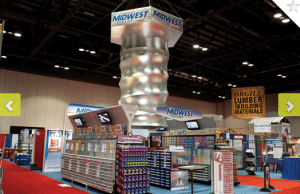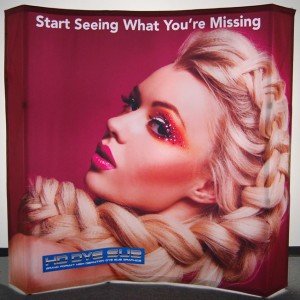The 15 Deadliest Trade Show Mistakes
We’ve written before on the subject of mistakes people make at trade shows, and I wish I could say that was the end of the story. However, people keep making mistakes—in some cases, the same darn mistakes over and over!
So we’re revisiting the issue with this list of the fifteen most deadly common trade show booth mistakes we’ve seen people make.
They’re not going to get you killed, but they will be destroy the results you were hoping to achieve from your trade show marketing investments. And they’ll kill the excitement, fun and learning that can come from working a trade show properly. (Yes, it can be fun!)
Hang onto your hats, because here we go:
1) Table it.
If your standard practice is to set up a trade show backdrop or trade show back wall exhibit and place the table provided by the show across the front of your booth space, you’re killing your chances of meeting more people and getting them more interested in your product or service.
Why? Because you’ve basically built a barricade between you and the people you want to talk with!
Now, a barricade worked well in the second act of Les Miserables, but that’s a different story.
You want to welcome people in, not keep them out. This is how to work a trade show.
If you must use the table, one of the trade show booth best practices is to place it along one of the ends of your booth space (from front to back), allowing open access from the aisle to your exhibit.
2) Going to the trade show without…
If you go to a show without stated objectives, you’ll accomplish exactly what you planned: nothing!
Even if your objectives are simply to “increase sales” or “get more leads,” there’s a process behind making that happen.
It just doesn’t occur magically if you show up.
You should at least attach a number to those goals (“increase sales by 15%” or “get 25 more leads”).
It’s a good bet that what you want to accomplish on the show floor is more than just leads or sales.
It probably aligns pretty well with your overall marketing goals. Put them in writing, get agreement from the team, then go to the show and get to work.
3) Focusing on money.
I know you can’t just go to a trade show and throw around blank checks.
But if you’re constantly trying to save a few bucks on everything, you’ve got the wrong attitude. Saving $50 or $100 here and there is keeping your focus on what you’re spending, rather than on the overall investment you’re making.
And chances are, a few hundred dollars saved isn’t going to amount to much in the long run.
But spending a little extra for nicer carpet or padding, a few attractive plants and a professional looking exhibit will put you a step ahead of other exhibitors and make your presence more memorable.
4) Penmanship problems on your trade show forms.
We all make mistakes, but if you foul up when you’re filling out show forms, it can cost you big time.
There are several ways to do this: you can forget to fill out a form, miss filling it out in time, miss submitting it on time, or fill it out incorrectly.
All these things will eat into your budget and get you nothing in return.
Skip a form and you might just show up and find you don’t have a booth space.
Fill it out late and you miss the early-bird discounts.
Complete one incorrectly (asking for a 20 volt circuit instead of 20 amps, for example) and you’ve taken a big hit. That hit is even bigger if it’s on a weekend set up day.
A recent real life example; a client asked us to schedule shipping back from their show. We did so, but when our freight company arrived, they were turned away, because the client had forgotten to submit the form to notify show management that our carrier was coming for their shipment.
Result? A visit fee from the scheduled carrier, because they had to wait an hour in line before being turned away, plus $500 in added costs that the show management’s “preferred” carrier charged, in excess of the quote from the scheduled carrier.
That’s an expensive form!
5) Wrong-sizing your trade show exhibit design.
“Right sizing” was a great buzzword for shrinking the ranks in corporate America, and it felt so much better than saying “lay-offs,” didn’t it?
But you can “wrong size” your exhibit and get burned, too.
For example, you can go too big (taking a 20 x 20 foot booth space at all the shows you attend) and waste tons of money when a 10 x 10 booth would have done just as well at many of those shows.
On the other hand, if you go too small, you might just disappear along the aisles or in back corners.
Bigger booths can include presentation areas, product displays, conference rooms and other niceties that just don’t work as well with less real estate.
So how do you find the right size for your company’s exhibit? Consider this: match what your competitors are doing, and you should end up not too big, not too small, but just right. We find this is to best way to determine what to take to a trade show.
For the most part, stay out of the bars while working trade shows! Click To Tweet6) “Cheers” didn’t take place at a trade show.
Remember that 80’s TV show about the Boston bar where everybody knows your name?
Trade shows aren’t necessarily that welcoming.
And if nobody knows you’re there, you won’t get the results you were counting on.
It’s up to you to publicize your presence in every way you can think of: notes, calls and emails to current customers and prospects, inviting them to visit your booth.
Advertise in the show directory.
Use social media to support your presence at the show.
Consider sponsorship of some aspect of the show, if that’s possible for you.
If it’s a B2C show, advertising in the local paper might even be a good idea. (And for the most part, stay out of the bars!)
(And for the most part, stay out of the bars!)
A few weeks prior, think of how to stand out at a trade show and have a plan of action before you go.
7) Ignoring your surroundings.
Practically within arm’s reach, there are companies and individuals that could be great partners or networking contacts.
But if you go to a show with the idea that you’re only there to pitch your product, you’ll miss the chance to walk the aisles, check out what your competitors are doing, and look around for new ideas.
There are a ton of trade show examples for you to see. Look at their trade show booth layout and collect a few trade show set up ideas. Look at how their displays and see if you can find some trade show signage tips. Talk a little bit, ask some trade show questions and see what information you can get.
And don’t forget that trade shows can be a great place to meet potential new employees, as well.
Get out of your own exhibit and see what else is happening around you. You’ll be glad you did.
Next week, we’ll share the rest of my “15 Deadliest Trade Show Mistakes.” But I hope these trade show tips has given you enough to think about for now. Avoid these seven, and you’re well on your way to having much more successful trade show exhibitors. Avoid all fifteen tradeshow mistakes, and you’ll be in the Exhibitor’s Hall of Fame!
For more, see our trade show articles on trade show mistakes to avoid and what you can learn by going to the wrong trade show.
One more thing: your exhibit can be a help or a hindrance to selling on the show floor. If your present exhibit isn’t part of the solution, it’s part of the problem. Let American Image Displays show you what a new booth can do to improve your trade show results and improve your tradeshow exhibit design. Call us at (425) 556-9511 or email [email protected].
[optin-monster-shortcode id=”kgycuhbazh-post”]

